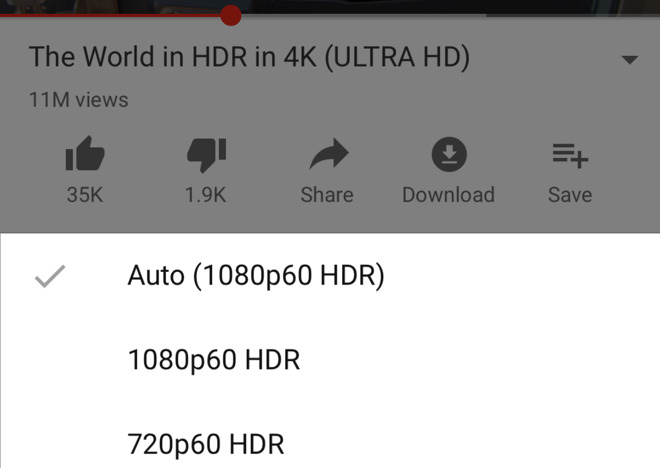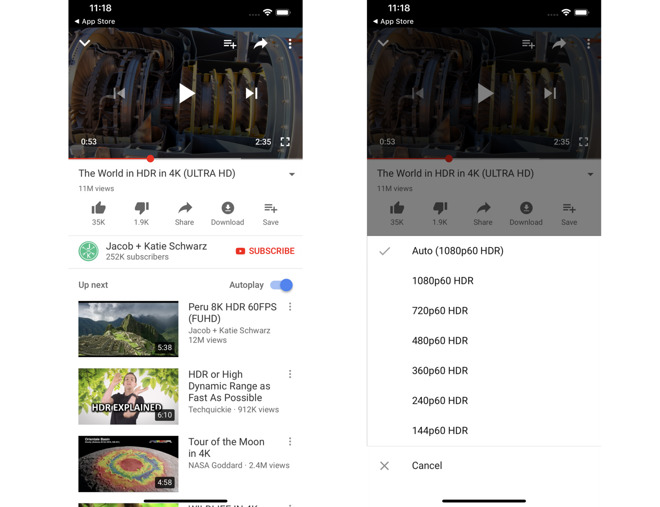YouTube for iOS gains HDR support for iPhone XS and XS Max, still lacks 4K
The YouTube app for iOS has received an update that adds support for high dynamic range video on the iPhone XS and iPhone XS Max, but at the same time continues lack an option to view 4K-resolution video.

The update to version 13.37 of the iOS YouTube app adds new options to the video quality settings, with compatible clips now showing the letters "HDR" next to the resolution to denote the high dynamic range content. HDR options can be selected manually, but the Auto quality option will also enable HDR if it is available for the currently-viewed video.
HDR enables for a wider range of colors in a video to be displayed on a compatible screen, such as is the case for the Apple TV 4K and a supported HDR-enabled 4K TV. The effect can allow for a brighter, detailed, and more vivid picture, with less color banding and other digital approximation artifacts.
The OLED displays used in the iPhone XS and XR offer high contrast ratios, enabling it to be suitable to view HDR content, both created by the onboard cameras and those downloaded or streamed to the device through online services.

The addition of HDR to the app for the XS range was not announced by YouTube. The release notes for the app version simply state it includes bug fixes and improved its performance, with no mention of additional device support for HDR.
The YouTube app has had HDR support since May, specifically for the iPhone X, with the latest update extending that same support to the newer models.
While HDR support is likely to be welcomed by users of those devices, the app continues to avoid providing any higher resolution options than 1080p, with 4K content displayed on the iPhones at a downsampled resolution. The problem is not only restricted to iPhones, as iPads with higher-resolution displays and the Apple TV 4K are unable to play 4K or higher-than-1080p content.
The issue is also evident on macOS, as while Chrome can offer YouTube videos at up to 4K resolution, Safari is limited to only 1080p at most.
The problem is likely to be down to Apple's lack of OS-level support for Google's VP9 codec, used by YouTube. While it remains unclear when or even if Apple will include VP9 support in its software and devices, it is also unknown if Google will work around Apple's decision not to use the codec in software as it has done on the Xbox One, if only to enable 4K or 1440p video streams on hardware that could play it.

The update to version 13.37 of the iOS YouTube app adds new options to the video quality settings, with compatible clips now showing the letters "HDR" next to the resolution to denote the high dynamic range content. HDR options can be selected manually, but the Auto quality option will also enable HDR if it is available for the currently-viewed video.
HDR enables for a wider range of colors in a video to be displayed on a compatible screen, such as is the case for the Apple TV 4K and a supported HDR-enabled 4K TV. The effect can allow for a brighter, detailed, and more vivid picture, with less color banding and other digital approximation artifacts.
The OLED displays used in the iPhone XS and XR offer high contrast ratios, enabling it to be suitable to view HDR content, both created by the onboard cameras and those downloaded or streamed to the device through online services.

The addition of HDR to the app for the XS range was not announced by YouTube. The release notes for the app version simply state it includes bug fixes and improved its performance, with no mention of additional device support for HDR.
The YouTube app has had HDR support since May, specifically for the iPhone X, with the latest update extending that same support to the newer models.
While HDR support is likely to be welcomed by users of those devices, the app continues to avoid providing any higher resolution options than 1080p, with 4K content displayed on the iPhones at a downsampled resolution. The problem is not only restricted to iPhones, as iPads with higher-resolution displays and the Apple TV 4K are unable to play 4K or higher-than-1080p content.
The issue is also evident on macOS, as while Chrome can offer YouTube videos at up to 4K resolution, Safari is limited to only 1080p at most.
The problem is likely to be down to Apple's lack of OS-level support for Google's VP9 codec, used by YouTube. While it remains unclear when or even if Apple will include VP9 support in its software and devices, it is also unknown if Google will work around Apple's decision not to use the codec in software as it has done on the Xbox One, if only to enable 4K or 1440p video streams on hardware that could play it.

Comments
As for mobile devices, this is especially true. No real need for 4K on a display that small. Where I notice the difference with 4K is on TVs that are 65" and larger where the seating distance is less than 8 feet.
Google just doesnt get UI.
Not me.
Does the iPhone now support 4K HDR streaming via AirPlay? I know the YouTube App supports HDR via ChromeCast from the iPhone, but I'm not sure whether that's 4K or 1080p.
Fast forward to 4K video and Google say a fresh opportunity to wrest control of the video compression technology market with VP9 while the industry consortium developed H.265 (HEVC). With the increasing power of Youtube, Google made VP9 the default codec across all platforms. But there was still the problem of H.265 and it's leader, Apple. Apple wanted no part of supporting a Google developed standard and many of the industry partners wonder whether VP8/9's "lack of patent infringement" would ever stand up in court. But going to court would be expensive, last years and in the end, probably not accomplish much of anything. So Apple decided the best strategy was to ignore VP9. They wouldn't implement in system level libraries and they certainly wouldn't put it in A-chip silicon. If Google wanted to implement it in software, it was up to them for their own products.
Google struck back and wouldn't support H.265 on Youtube for 4K video. That leaves out iPhones, and Apple TV. Google's own Chrome browser would do it on the Mac, but that's about it. And the stalemate has been this way ever since.
Tell me about it. The moment you pause the video, half the screen is covered by icons for the other videos in the channel and the control buttons. They take a couple of seconds to clear off when you play, thereby making sure you miss a bit every time you pause and play.
The "enhancements" in the last update were a massive step backwards in usability, IMO.
1440p resolution is greater than 1080p but less than 2160p (4K). For the sake of detail with fewer artifacts, resolution scalers prefer dealing with more information and scaling down, not less information and scaling upward. And the A11/A12 chips are more than capable of downscaling 2160p content.
There are currently four different patent pools and several separate companies that claim to hold IP reading on H.265, and at least one of those "standards" is leaving open the possibility of end-users being dinged for royalties. It's certainly possible the whole HEVC effort will end up eventually abandoned. Dead. Buried. A victim of infighting among the players, and greed from the companies holding IP that reads on it. Some of them still today refuse to FRAND license to any of the H.265 groups in order to craft their own royalty claims, Nokia being one of the more prominent ones.
That's why there's broad industry involvement in the Google-supported and royalty-free AV-1, built upon VP9 for the most part with additional code contributions from other industry titans. Even Apple has joined up with Google in the AV-1 group.
Surprise.
https://bitmovin.com/apple-joins-av1-codec-consortium/
EDIT: Here's what the head of MPEG itself, Leonardo Chiariglione had to say about it a few months back:
“At long last everybody realizes that the old MPEG business model is now broke, all the investments (collectively hundreds of millions USD) made by the industry for the new (H.265) video codec will go up in smoke and AOM’s royalty free model (AV1) will spread to other business segments as well.”
http://blog.chiariglione.org/a-crisis-the-causes-and-a-solution/
This is evident in my ulpoads where there is lots of motion, or my music uploads when listening to side by side comparisons. Appple's decision not to allow VP9 on their browsers and phones is pure politics, but the sad part is it's degrading quality for millions of viewers who have part of their business on YouTube and I'm an OSX fan.
Please remember it's not just about 4K, the VP9 codec effects all resolutions. I ulpload all videos to my channel in 1440P, and sadly not Apple compatible. It is compatible on Chrome, Firefox, Opera, and all Android phones.